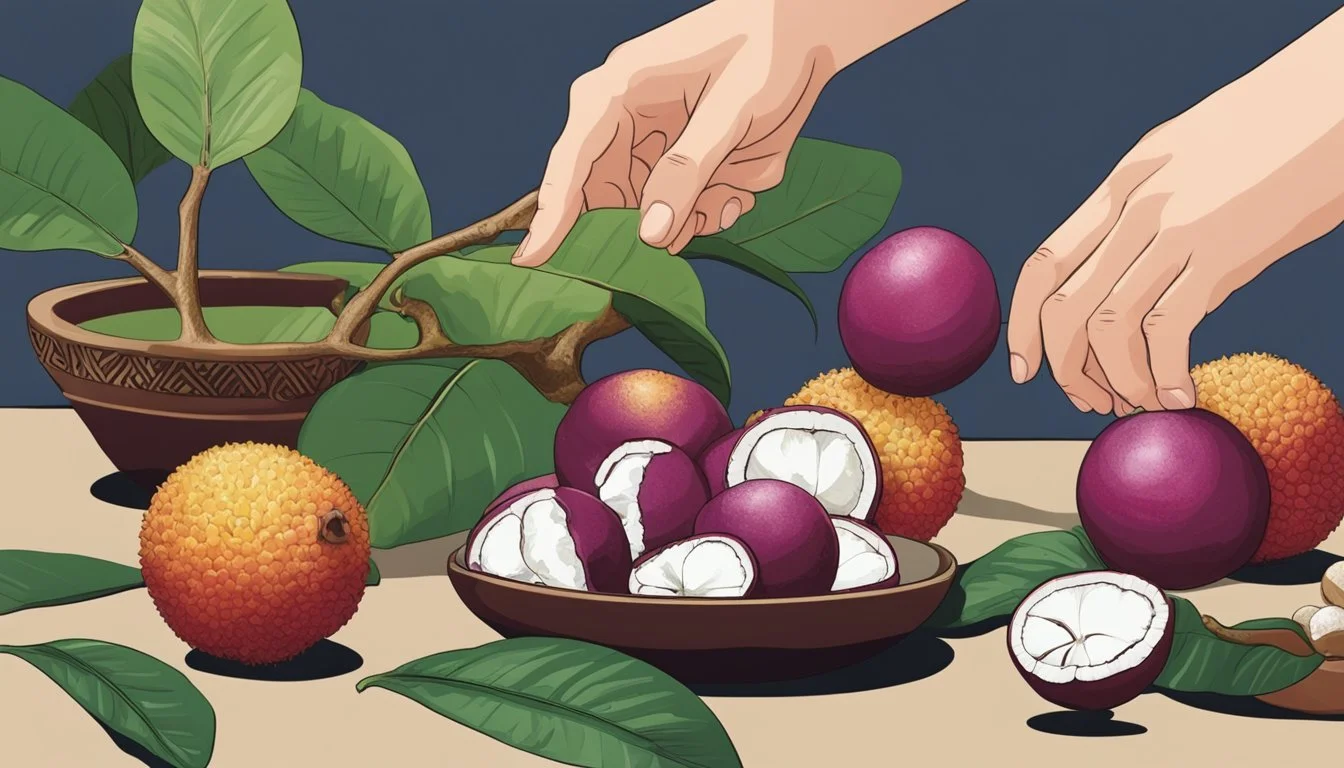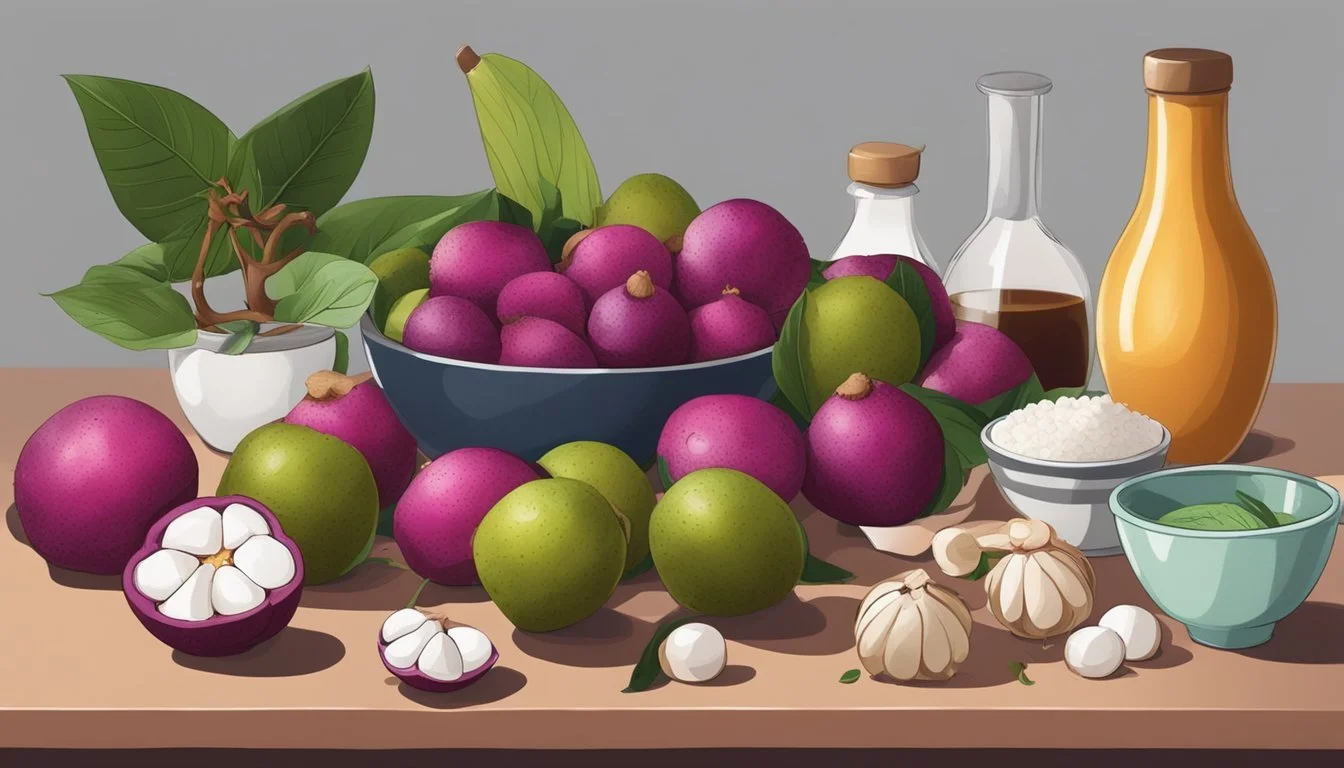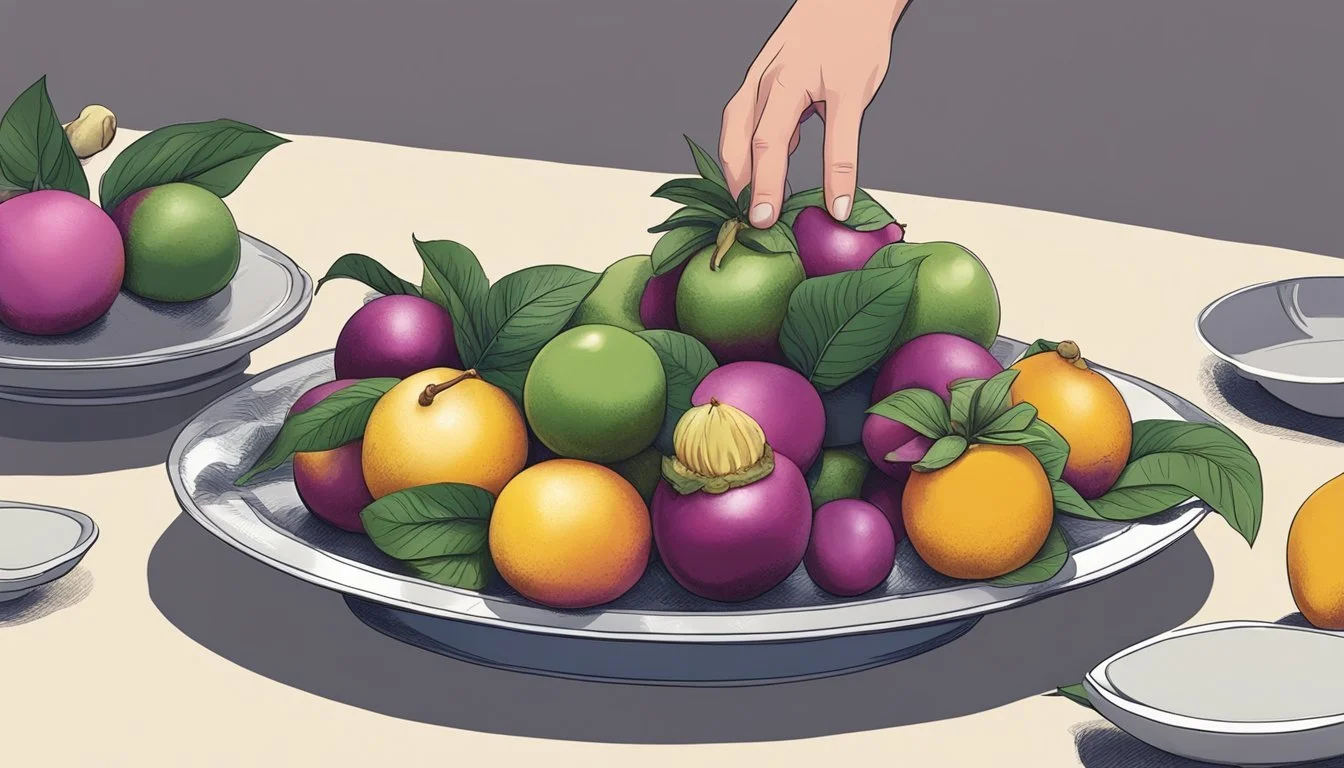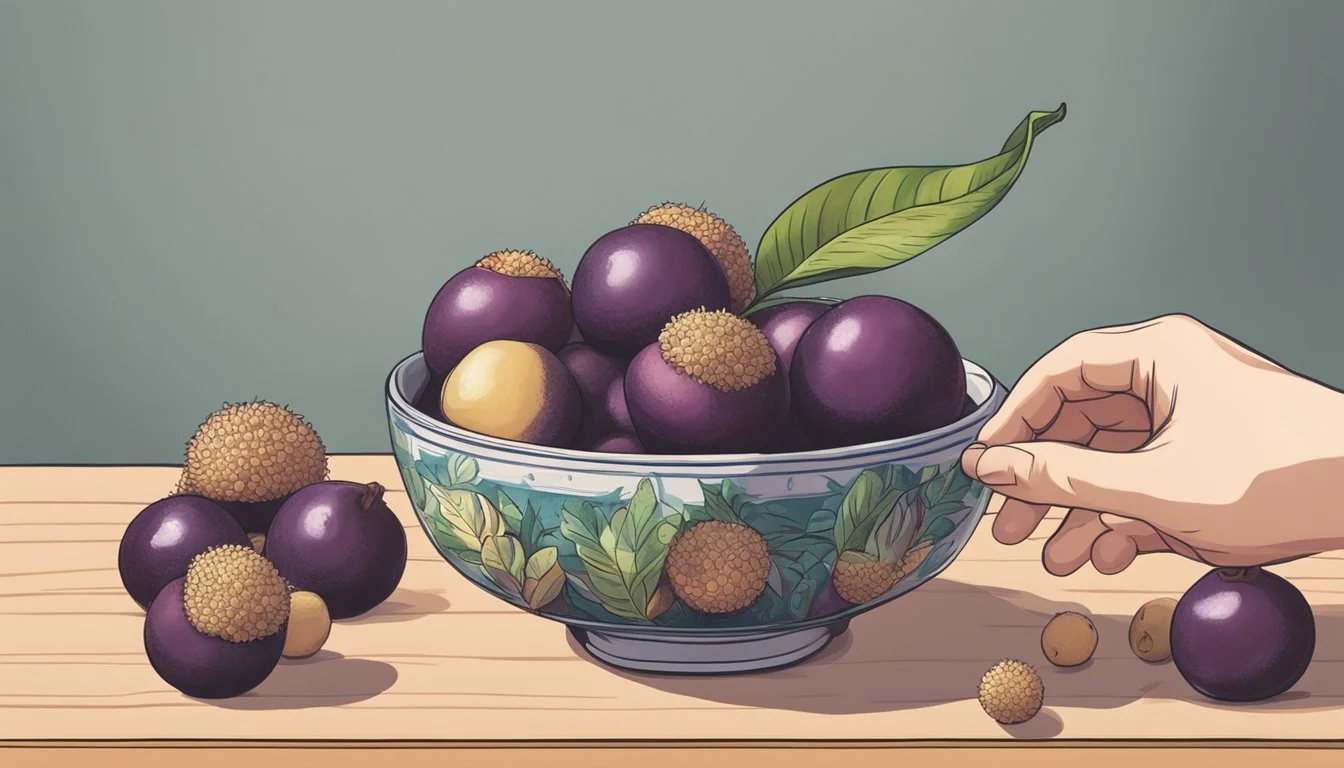How to Substitute Mangosteen for Lychee
A Simple Guide for Fruit Lovers
Mangosteen and lychee are both tropical fruits (What wine goes well with fruits?) cherished for their unique flavors and succulent textures, making them popular choices for various culinary applications. Occasionally, one may need to substitute mangosteen for lychee, whether due to availability issues or personal preference. Substituting these fruits effectively requires an understanding of their individual taste profiles and textures to ensure that the essence of the dish remains intact.
When considering mangosteen as an alternative to lychee, it's important to note the subtle differences that may influence the final outcome of a recipe. While both fruits share a sweet and tangy flavor profile, mangosteen offers a slightly creamy and citrusy note that contrasts with the juicy burst of a lychee's flesh. To achieve a harmonious balance in recipes calling for lychee, the soft and segmented nature of mangosteen's interior can be harnessed to mimic the textural aspects of lychee, although the size and consistency of the seeds differ.
In crafting dishes where lychee is a staple ingredient, replicating the moisture content is also key. Mangosteen's firmer flesh can be enriched with additional liquids to echo lychee's juiciness or combined with other ingredients that complement its creamier undertone. This ensures that the substitute does not only fulfill the textural requisites but also blends seamlessly into the flavor tapestry, allowing chefs and home cooks to adapt their recipes without compromising on the desired taste sensation.
Understanding Mangosteen and Lychee
As tropical fruits, mangosteen and lychee offer unique tastes and nutritional benefits. They are both enjoyed worldwide and are often sought after for their distinctive flavors and potential health benefits.
Origin and Popular Regions
Mangosteen (Garcinia mangostana) is often celebrated as the "queen of fruits" and is native to Southeast Asia, including countries like Indonesia, Malaysia, and Thailand. Lychee (Litchi chinensis), on the other hand, originated in China and now enjoys popularity in various regions of the world, including Southeast Asia, India, and the Philippines.
Nutritional Profile
Both mangosteen and lychee are nutritious, offering a variety of vitamins and minerals. Mangosteens provide a good source of vitamin C, fiber, and powerful antioxidants. Lychees, while also rich in vitamin C, offer substantial amounts of vitamin B6, copper, and potassium.
Here's a quick comparison of their nutritional content per 100 grams:
Nutrient Mangosteen Lychee Calories 73 kcal 66 kcal Fiber Moderate Less Vitamin C High High Vitamin B6 Not significant Significant Minerals Iron, Calcium, Magnesium Potassium, Copper, Phosphorus
Physical Characteristics
Mangosteen has a deep purple rind with a soft, segmented white interior that houses small, sometimes edible seeds. Its size can be compared to that of a regular orange. Lychee has a rough, reddish-pink outer skin, encasing translucent flesh with a larger inedible seed. It's juicier than mangosteen and typically smaller in size. Both fruits offer a sweet and slightly acidic taste profile, although the lychee's flavor is often described as fresher and more floral.
Culinary Uses of Mangosteen and Lychee
Mangosteen and lychee, both celebrated tropical fruits, bring unique and sweet flavors to various culinary creations. While their flavors are distinctive, they can often be substituted for one another in many dishes.
Common Dishes and Recipes
Mangosteen's rich, sweet flavor and soft texture make it a versatile ingredient in cooking. It is commonly used as a garnish for savory dishes and can be found in sauces, such as black bean sauce, to add a touch of sweetness. Lychee, with its juicy consistency and floral notes, is frequently utilized in cocktails and juices, infusing a fragrant sweetness that complements both the aroma and taste of beverages. When cooking with these fruits, chefs might add them to salads to imbue a tropical essence, or incorporate them into savory dishes to balance flavors with their innate sweetness.
Dessert Applications
In the realm of desserts, both mangosteen and lychee shine with their ability to enhance the flavor profiles of various sweets. They are often incorporated into:
Smoothies: Their sweetness enriches these blended beverages with a tropical twist.
Ice Cream: Both fruits serve as tantalizing mix-ins or flavorful bases.
Puddings and Muffins: Small pieces can be added to these baked goods for bursts of fruity moisture.
Deserts: They can top cakes and tarts, or be used as a central component in fruit desserts.
When used as a dessert garnish, they not only add flavor but also make for an appealing visual presentation.
Taste and Texture Comparison
Substituting mangosteen for lychee in culinary uses requires understanding the unique taste and texture profiles of each fruit.
Flavor Profiles
Mangosteen and lychee offer distinct sweet flavors that stand out in exotic fruit palettes. Mangosteen's flavor is often described as a mix between a grape, a peach, and a hint of floral notes, presenting a refreshing and subtly creamy taste. Lychee, also known as litchi, boasts a sweet yet slightly tart profile, reminiscent of a ripe grape or pear, with a floral, perfumed aroma that is truly unique to this fruit.
Fruit Textures
The texture of mangosteen's flesh is soft and succulent, similar to the consistency of a ripe peach, but without the fibrous qualities. It can be easily segmented, much like an orange. In contrast, lychee's flesh is juicy and firm, encased in a rough, bumpy skin that peels away to reveal the translucent fruit. The texture might be compared to a firmer, slightly more dense grape. Both fruits are enveloped by a rind, but while mangosteen's rind is thick and inedible, lychee's is thin and easily removable.
Substituting Mangosteen for Lychee
Mangosteen and lychee can be substituted for one another in recipes where the nuances of their flavors and texture are not the focal point. The following subsections will guide you through the process of substitution, addressing sweetness, texture, recipe applications, and considerations for culinary uses.
Adjusting for Sweetness and Texture
Mangosteen tends to have a slightly less sweet profile and a softer, matte-textured flesh compared to lychee's juicier bite. When substituting mangosteen for lychee, one might:
Mangosteen→Lychee: Add a tiny amount of sugar or honey to match the sweetness level of lychee.
Texture: Puree mangosteen to a fine consistency if the recipe requires the firmer texture of lychee.
Application in Tropical Fruit Recipes
Tropical fruit recipes often celebrate the exotic flavors of their ingredients. Mangosteen, when used as a substitute for lychee, should be:
Proportion: Use a 1:1 ratio of mangosteen for lychee for simplicity and to maintain the fruit balance in the recipe.
Desserts and Salads: Dice or scoop mangosteen into small pieces to replace lychee in desserts, salads, smoothies, or cocktails.
Considerations for Cooking and Garnishes
When cooking or garnishing with mangosteen in place of lychee:
Heat: Apply gentle heat when cooking mangosteen, as its fleshy texture may disintegrate more easily than lychee.
Garnishes: Use mangosteen segments whole as an attractive garnish on plates, bearing in mind their softer texture.
Health Benefits and Nutritional Importance
Substituting mangosteen for lychee in your diet introduces a variety of health benefits and essential nutrients. Both fruits are celebrated for their unique contribution to nutrition, offering a bounty of vitamins, minerals, and antioxidants conducive to a healthy diet.
Vitamins and Minerals
Mangosteen and lychee are treasure troves of vitamins and minerals pivotal for maintaining good health. They both contain Vitamin C, known for its immune system support and antioxidant properties. While mangosteen provides a substantial amount of potassium, essential for blood pressure regulation, lychee offers copper and folate, assisting in the formation of red blood cells and supporting metabolic health.
Mangosteen is rich in:
Vitamin C
Iron
Magnesium
Lychee contains significant amounts of:
Vitamin C
Potassium
Copper
Folate
Dietary Fiber and Antioxidant Content
Both fruits are high in dietary fiber, which is vital for digestive health, but mangosteen particularly shines for its impressive antioxidant content. Antioxidants are crucial as they combat inflammation and protect the body from oxidative stress. Mangosteen is credited with a diverse range of antioxidants, including xanthones, which have been studied for their potential anti-inflammatory effects.
Fiber content in mangosteen helps in:
Reducing cholesterol levels
Regulating sugar absorption
Antioxidant properties aid in:
Neutralizing harmful free radicals
Reducing risk of chronic diseases
Supporting a Healthy Diet
Incorporating mangosteen or lychee into a diet has its merits in terms of calorie content and the absence of cholesterol, which makes them a heart-friendly choice. The low fat and moderate sugar levels contribute to a balanced diet, with mangosteen being particularly noted for its role in weight management. The fruit's potential influence on improving insulin sensitivity could make it an integral part of a diet tailored for those monitoring their blood sugar levels.
Mangosteen and lychee offer:
Low fat
Cholesterol-free
Moderation in calories and sugar
Protein content is minimal, making them perfect for:
A low-fat diet
Reducing intake of high-calorie snacks
Storage and Preservation
When substituting mangosteen for lychee, it is important to understand how to properly store and preserve these tropical fruits to maintain their freshness and nutritional content.
Storing Fresh Fruits
Storing mangosteen follows specific guidelines to ensure its quality remains intact. It should be kept at a cool temperature, ideally around 10°C (50°F). Storing mangosteen at this temperature helps to prolong its freshness. However, placing mangosteen in the refrigerator is not advised as it can damage the fruit's flavor and texture. In contrast, fresh lychee has a slightly different storage requirement. As a subtropical fruit, lychee tends to be more resilient in colder temperatures and can be refrigerated. To retain optimal freshness and prevent drying out, lychees should be placed in a plastic bag with perforations to allow for some air circulation and then kept in the refrigerator.
Preserving Flavor and Nutrients
There are several methods to preserve the flavor and nutrients of mangosteen and lychee when they are not available fresh. Mangosteen can be frozen, either whole or segmented, which can extend its shelf life substantially while somewhat maintaining its quality. For retaining the most flavor and nutrients, freezing should be done as soon as possible after purchase. Similarly, lychees can also be frozen, preferably pitted and peeled, and stored in airtight containers to minimize exposure to air and prevent freezer burn. Both fruits may lose some of their fresh texture once thawed, but they will still be suitable for use in recipes that don't require the precise texture of fresh fruit, such as smoothies or purees.
Availability and Selection
Deciding on mangosteen as a substitute for lychee requires understanding their unique seasonality and how to select ripe fruits. Both fruits are refreshingly sweet and embody the essence of tropical exuberance.
Seasonality
Mangosteens and lychees are vibrant tropical fruits that thrive in warm climates and have specific harvest times.
Lychee: Typically, the lychee season spans from May to July. During this period, one can find them fresh in various stores, especially those specializing in exotic fruits.
Mangosteen: It is less common than lychee and has a shorter season, primarily from June to August. Due to its rarity and more demanding growing conditions, mangosteen isn't as readily available outside tropical regions.
Choosing Ripe Fruit
Selecting ripe fruits is crucial for the best sensual experience, be it the aromatic lychee or the floral-noted mangosteen.
Lychee: Look for fruits with a bumpy, dry outer skin. They should have a vibrant red or pink color. The fruit is at its most refreshing stage when it's slightly firm to the touch.
Mangosteen: A ripe mangosteen will feel firm and have a deep purple rind. One should check for a green calyx at the stem end and give it a gentle squeeze; a ripe mangosteen will yield slightly without feeling mushy.
When substituting mangosteens for lychees, it's essential for one to find ripe, quality fruits to deliver the aromatic and sweet flavors expected of these exotic treats. While not always available in all stores, their presence is a refreshing hint of the tropics and their enticing, sweet, and floral notes are a valuable addition to various dishes.
Innovations in Tropical Fruit Uses
In the culinary world, the use of tropical fruits has evolved beyond traditional applications, opening doors to a myriad of innovative uses in food and beverages.
Beyond Traditional Use
Traditionally, tropical fruits have been consumed fresh or in straightforward preparations such as fruit salads. However, advancements in food technology and global cuisine have revolutionized their applications. Mangosteen and lychee, with their distinct flavors and textures, have transitioned from being exotic snacking options to key ingredients in health and wellness products. Their essential vitamins and minerals contribute to the nutritional profiles of new dietary supplements aimed at offering both taste and health benefits.
Modern preservation techniques, such as freeze-drying and infusions into syrups, enable these fruits to retain much of their juiciness and flavor, extending their shelf life and allowing for creative culinary uses year-round. The advent of tropical fruit powders has also made it easier for consumers to incorporate these flavors into their cooking, adding a tropical twist to both sweet and savory dishes.
Exotic Fruit in Modern Cuisine
Chefs have embraced tropical fruits for their ability to impart an exotic flair to contemporary dishes. Desserts featuring mangosteen or lychee bring a fresh, sweet-tart dimension that stands out in the crowded scene of sweet confections. For instance, a chef might substitute mangosteen for lychee in a panna cotta, adjusting the sugar content to account for mangosteen's natural sweetness.
Cocktails and mocktails are also benefiting from the innovative use of tropical fruits. Bartenders often incorporate juices, purees, or garnishes like mangosteen to craft vibrant, flavorful drinks. The fruits' various textures and flavors can be layered to create complex beverage profiles that are as visually appealing as they are delicious. A lychee martini, for instance, might see a novel reinterpretation with mangosteen, offering a creamier mouthfeel while maintaining the desired tropical essence.
Culinary professionals continue to explore the versatility of these fruits, integrating them into sauces, glazes, and even savory applications like marinades and salsas. The subtle flavor complexity of mangosteen can be paired with meats or seafood, enriching their taste without overpowering them.








